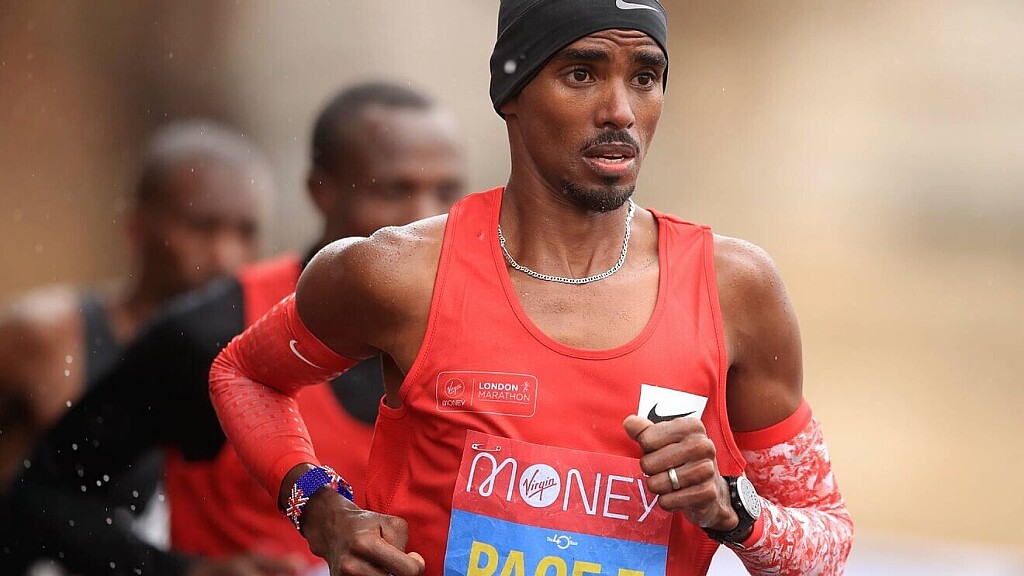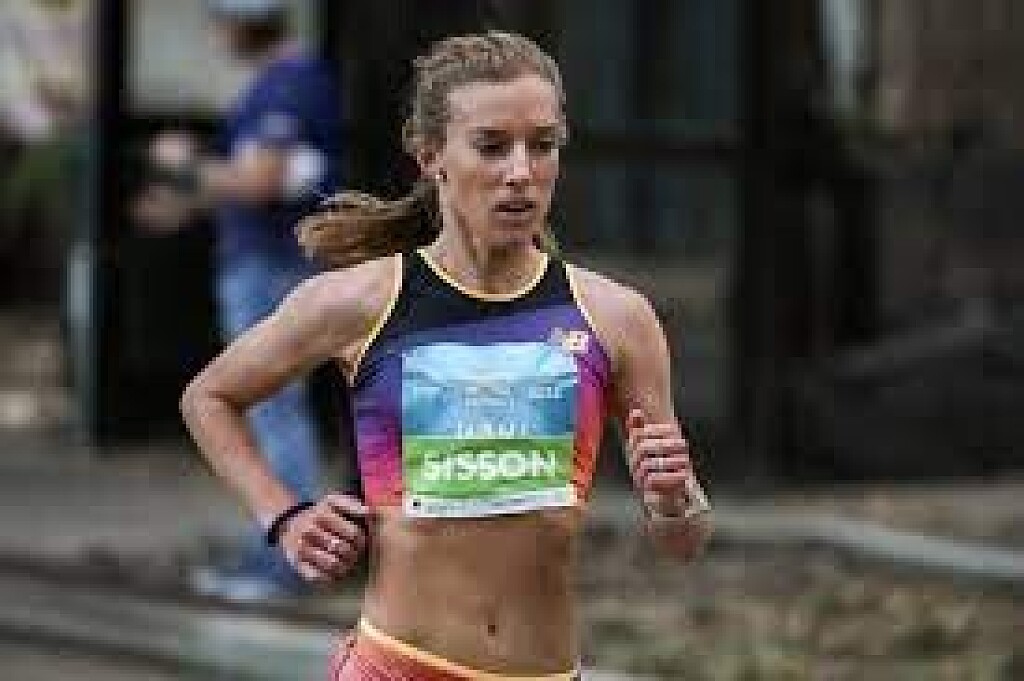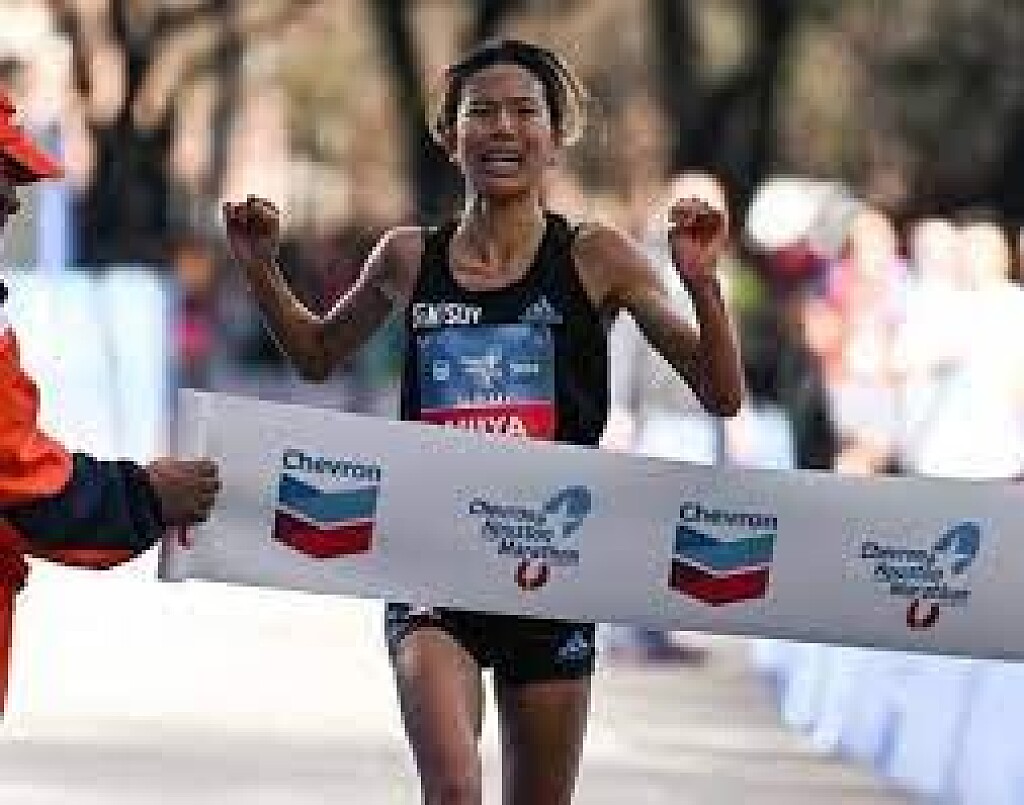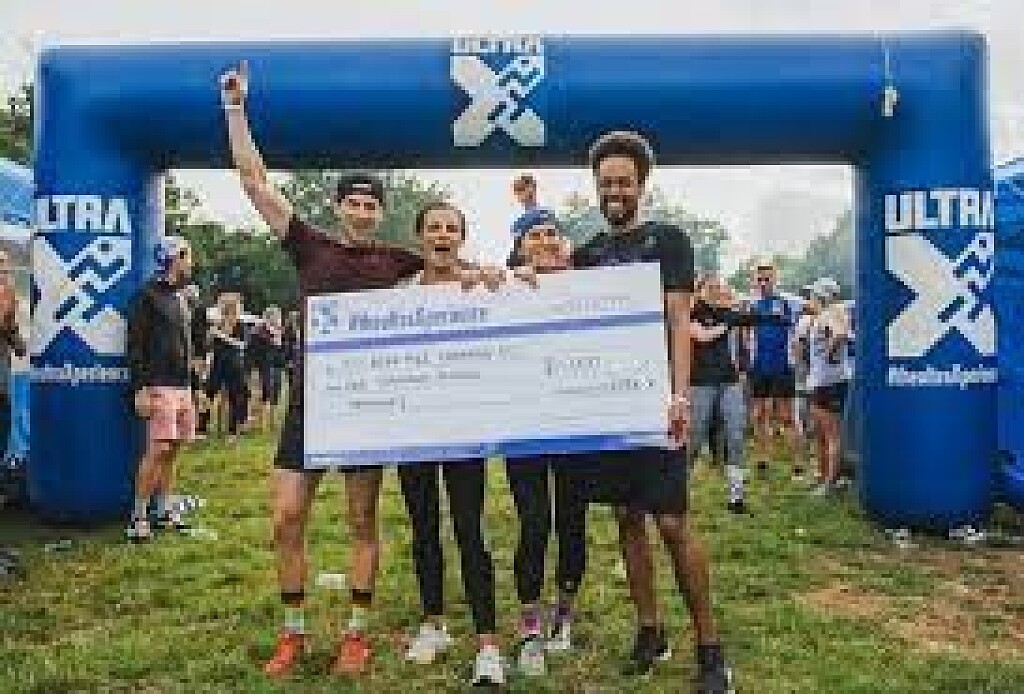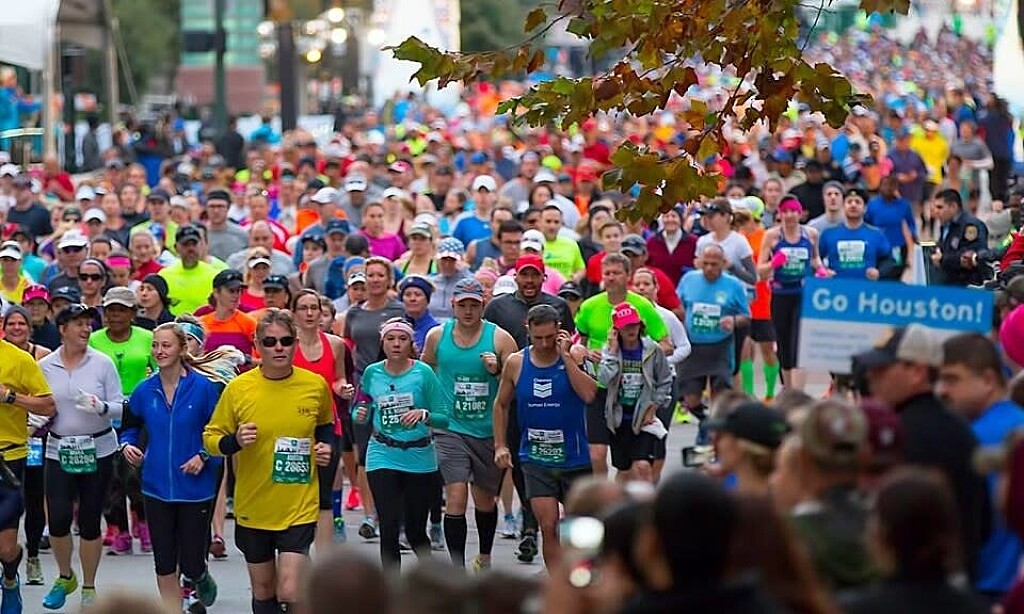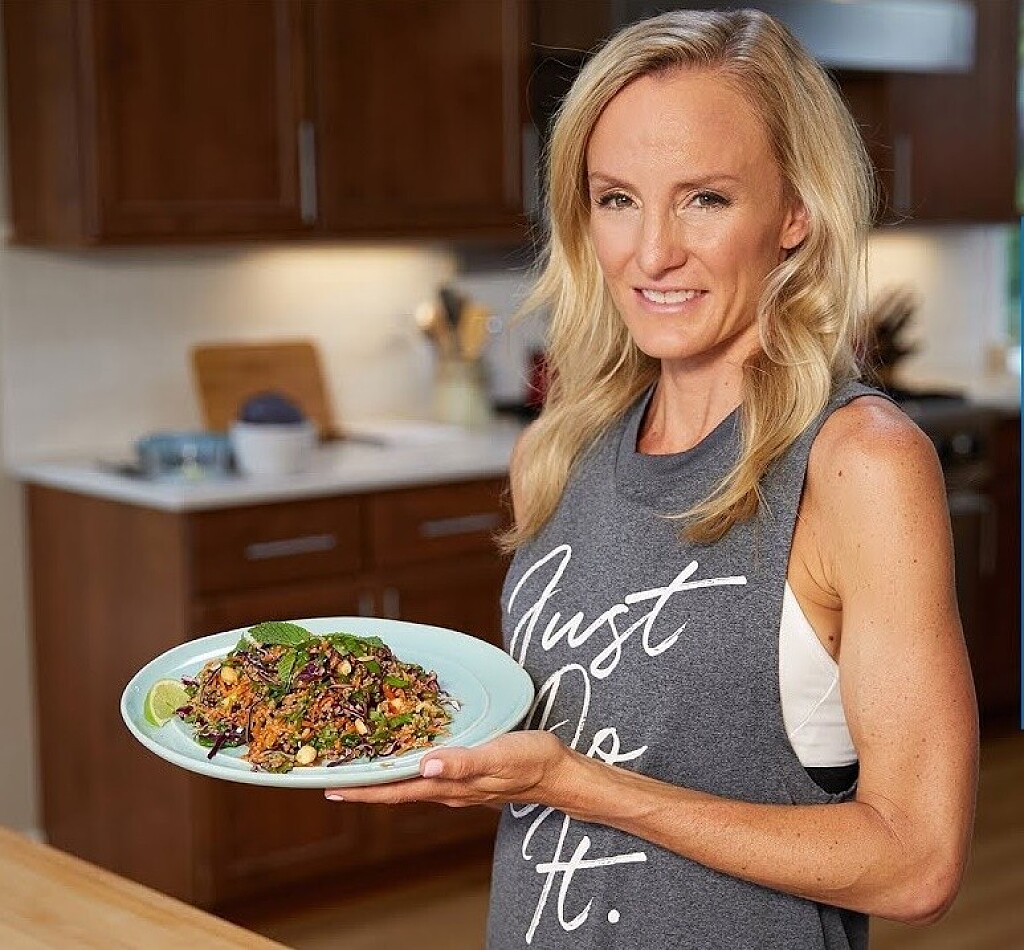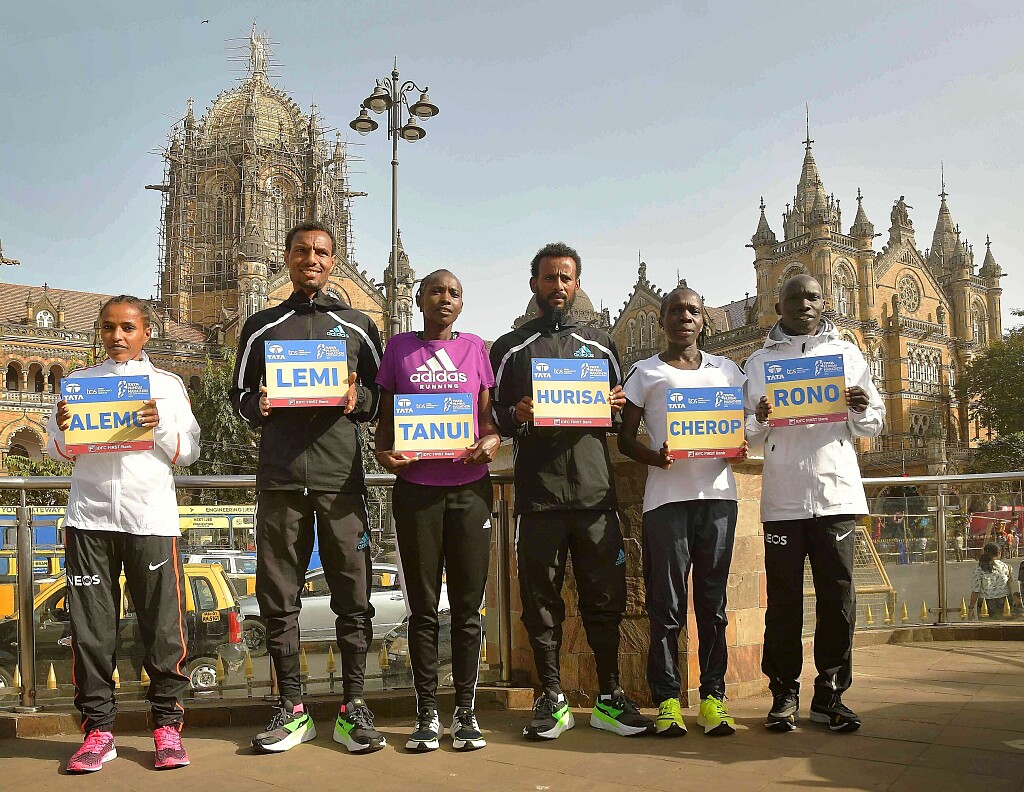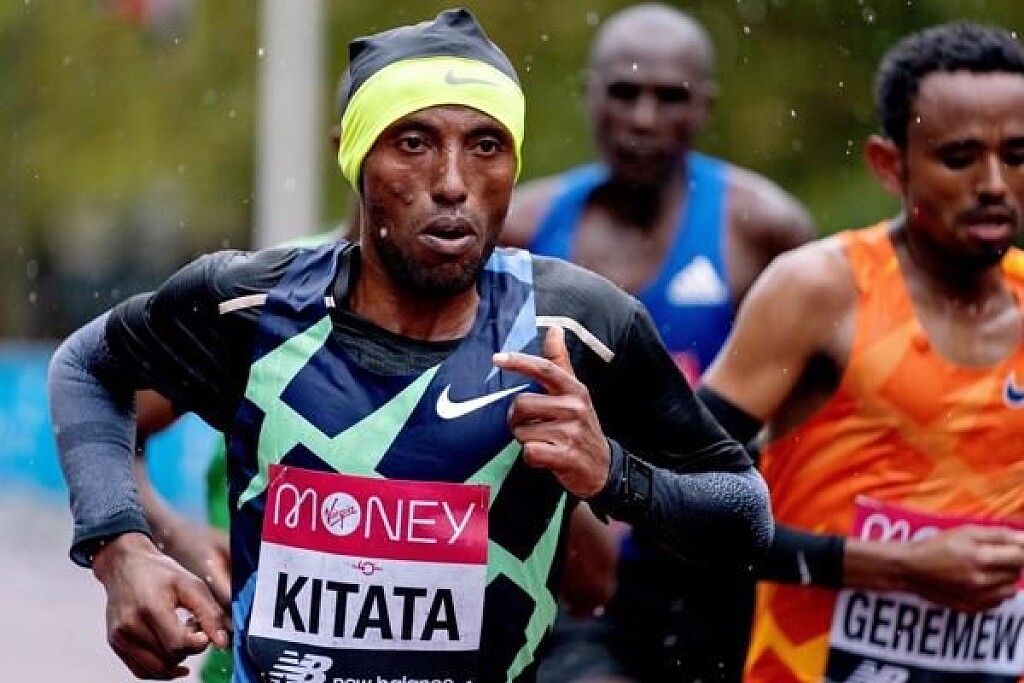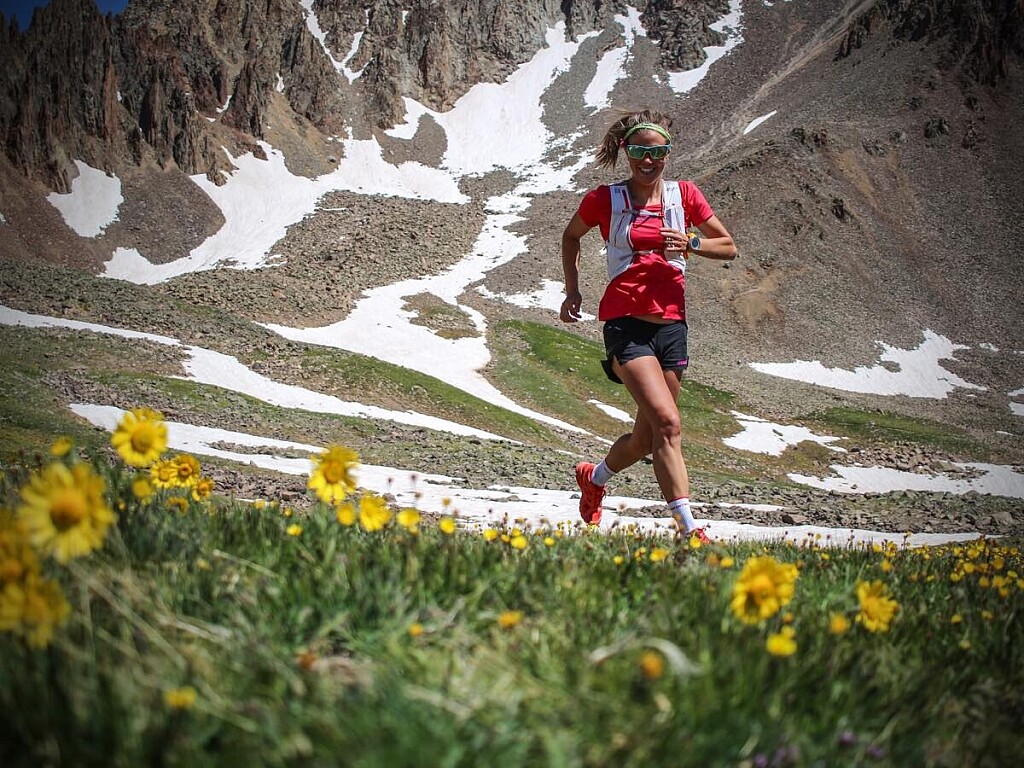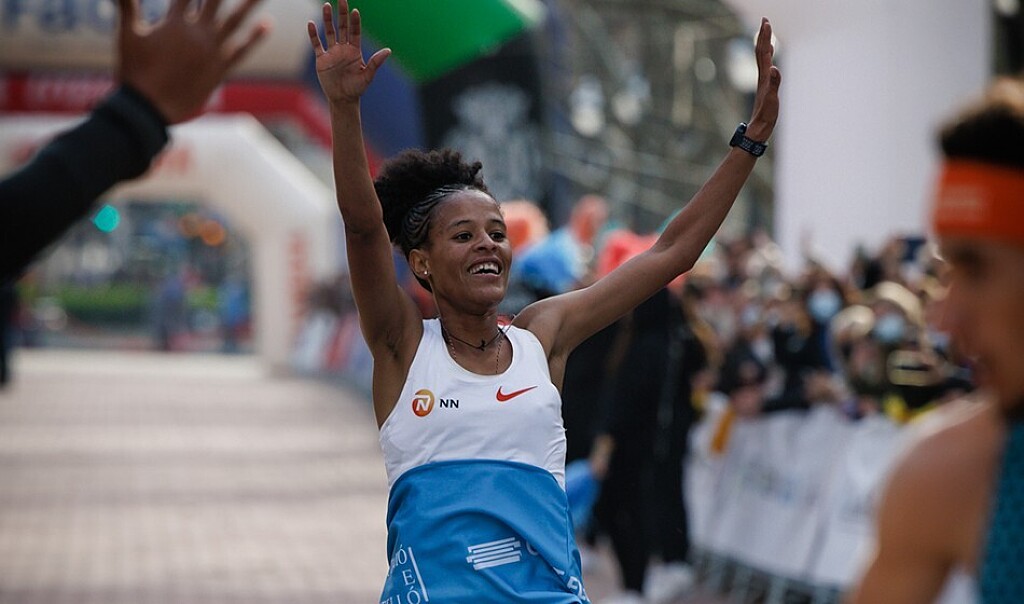Running News Daily
Top Ten Stories of the Week
1/21/2023
These are the top ten stories based on views over the last week.
Mo Farah: Nine Running Tips
Mo Farah – Olympic 5000m and 10,000m champion (twice), World 5,000m and 10,000m champion (twice) and 2:05 Marathoner. Someone we could all get a few running tips from.
The Sweat Elite team spent a month training in Sululta, Ethiopia in January 2019, whilst Mo Farah and Mudane Team were training towards the London Marathon 2019.
Here are 9 basic running tips from Mo Farah:
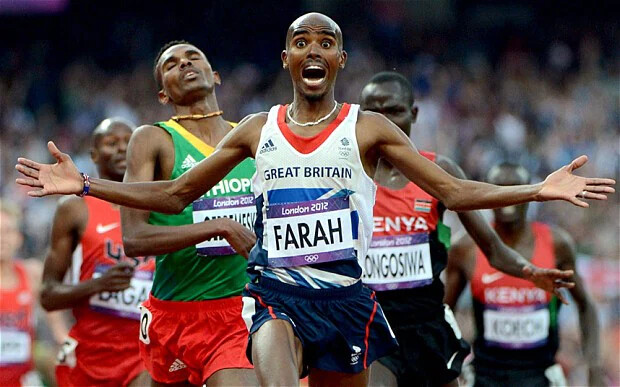
For A Quick Energy Boost… “Chocolate – usually dark chocolate – is good for an energy boost. There are all manner of sports snacks that pretend to do wonderful things, but I mostly like to stick to the basics.”
How to Keep Motivated… “When you’re competing, keep reminding yourself how much work has led to that moment. The training you’ve done means you deserve to perform well. That gives a huge confidence boost.”
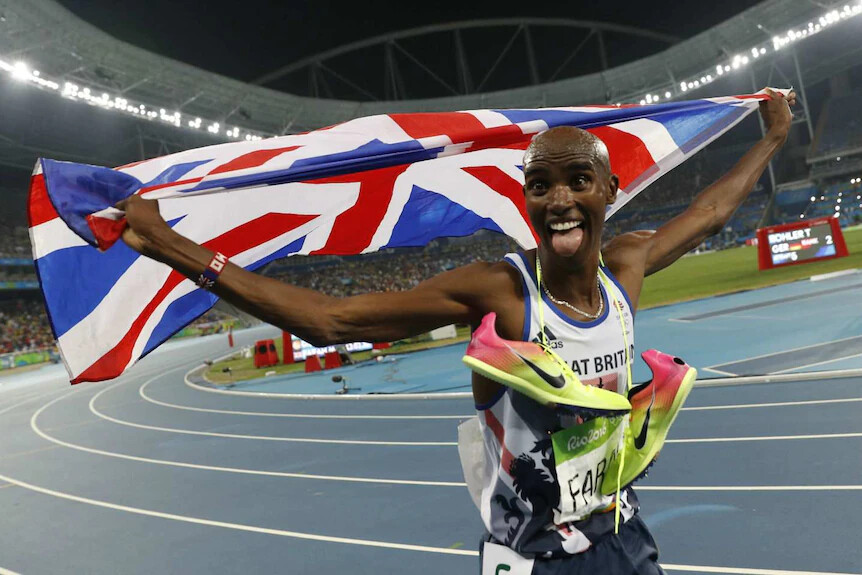
How Important Are Recovery Days? “The day after a tough workout, you never want to push your body again. The most you should do is a comfortable run (or two) and/or cross training. Don’t have your heart rate up high again.”
Should you carry water during a race?“Drink immediately before or after a 5K or 10K run, but not during it. Running with a bottle puts more pressure on whatever side of your body it’s weighing down, and running well is all about balance.”
Keeping Warm Before The Race… “The morning before a race, I always have to wear my leggings to warm up my muscles. It’s weird, but if I don’t wear leggings in the morning, then I can’t compete in the afternoon. It’s a psychological thing. My coach once said: ‘It’s hot, it’s 80 degrees, take the leggings off!’ But I couldn’t.”
Increase Your Mileage Gradually… “Do not increase your weekly mileage by more than 10 per cent every month. No matter how good you feel, be very gradual. You won’t know you’re overdoing it until it’s too late.”
Strengthen Your Whole Body… “Good runners condition their whole bodies. The arms drive the legs. Keep your upper body and core toned with a lot of push-ups, pull-ups, sit-ups, and back raises. Stay away from machine weights and stick to Pilates, climbing, and dynamic flexibility work like yoga.”
Think About Your Posture… “Every motion your body makes should propel you directly forward. If your arms are crossing or you are over-striding, you’re losing force. Your posture should be straight, and your striding foot should land directly underneath you.”
Stay On The Trails If Possible… “Pavement damages joints, tendons, ligaments and muscles. The more you can run on grass, woodchips or dirt, the better off you are. My athletes run 90 percent of their workouts on soft surfaces.”
(01/16/23) Views: 188Sweat Elite
Emily Sisson sets a new half marathon American record in Houston
Emily Sisson shattered her own American record in the half marathon by finishing in 1:06:52. She is now the first American woman to break the 1:07 barrier after placing second behind race winner Hiwot Gebremaryam of Ethiopia, who ran 1:06:28.
Ethiopian Leul Gebresilase Aleme won the men’s half in a sprint finish. He ran 1:00:34—less than a second ahead of runner-up Wesley Kiptoo of Kenya.
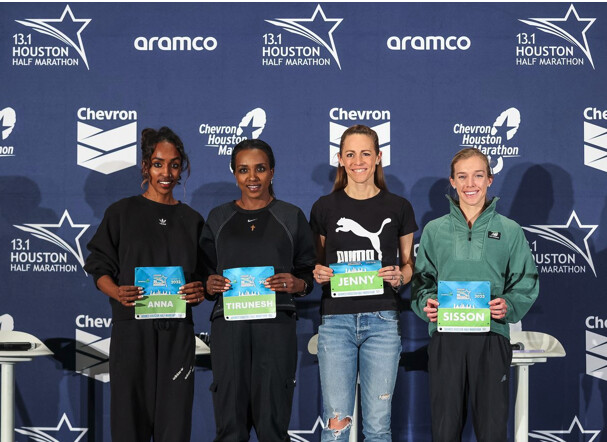
Emily Sisson Re-Breaks Her Own American Record
Sisson improved on her record the hard way by going out fast, slowing down slightly through the last sections, and kicking it in towards the finish. After Gebremaryam broke the race open in the first few miles—by 5K, she was already 17 seconds ahead of the chase pack—Sisson ran with Jessica Warner-Judd of Great Britain through 15K. The American record-holder averaged 5-minute mile pace through the first 5K but struggled in the latter half of the course, clocking 5:12 miles around 20K.
“I went out a little too fast the first 5K or so, so the last few miles I was definitely feeling it,” Sisson said on the ABC 13 broadcast.
But Sisson pushed through the discomfort as she neared the finish line to make history once again. “I’m really excited about it. I really wanted to break 67 minutes and I’m happy I did,” she said. “I actually think I could have run a little more evenly so I’m already hoping to run another half and even try to run faster.”
Sisson broke the American record for the first time in May 2022 at the USATF Half Marathon Road Championships in Indianapolis. The Providence College alum won the national title in 1:07:11, four seconds faster than the previous American record set by Sara Hall less than four months earlier at the 2022 Houston Half Marathon.
Prior to the U.S. championships, Sisson came extremely close to the mark on two occasions. When the record was 1:07:25 (held by her former training partner Molly Huddle), she ran 1:07:30 in 2019 and 1:07:26 in 2020.
Last year, the momentum continued in a big way for Sisson when she broke the American record in the marathon. In October, she demolished the time by running 2:18:29 in Chicago—lowering the previous record set by Keira D’Amato at the 2022 Houston Marathon by 43 seconds.
Close Finish in the Men’s Half Marathon
The men’s half marathon featured one of the most exciting finishes of the day. After pulling away from the chase pack together with a few miles remaining, Aleme and Kiptoo battled down to the wire. The East African competitors fought through the homestretch—where Kiptoo kept looking back to assess the distance between himself and his rival—until Aleme sprinted ahead at the last second to claim the victory.
Aleme’s performance follows a breakthrough season, which included a runner-up finish at the 2022 London Marathon in October.
Conner Mantz was the first American to finish after placing sixth in 1:01:12.
Past Greats Return to Racing, While Familiar Faces Make Debuts
In addition to Sisson’s record, there were several other notable performances in the Houston women’s half marathon, including Huddle in her postpartum return to competitive racing. The previous American record-holder finished fifth in 1:10:01 almost nine months after welcoming her daughter. In her 13.1 debut, former 1500-meter specialist and Olympic bronze medalist Jenny Simpson placed ninth in 1:10:35. Also making her debut, Vanessa Fraser finished 13th in 1:11:00. All three had room to spare in achieving the standard to compete at the 2024 U.S. Olympic Marathon Trials.
Three-time Olympic champion Tirunesh Dibaba also made her highly anticipated return. In the Ethiopian's first race in four years, she finished 16th in 1:11:35.
(01/15/23) Views: 136Runners World
2023 Houston Marathon was one exciting race right up to the finish
Thanks to record-breaking runs and heart-stopping finishes, this year’s races were memorably exiciting.
The Houston Marathon and Half Marathon are two of the fastest races in the U.S., and both occur on one exciting day. The competitive event delivered once again with a record-setting run and several memorable performances on Sunday, January 15.In the closest Houston finish since 1996, the men’s marathon was won by Dominic Ondoro. The Kenyan out-leaned Tsedat Ayana of Ethiopia to claim the victory in 2:10:36.
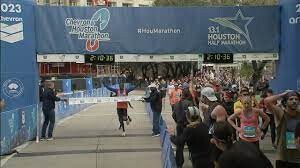
The women’s race saw another impressive run with Hitomi Niiya of Japan winning in 2:19:24, more than six minutes ahead of the runner-up.
What else might you have missed from the Houston Marathon and Half Marathon? Check out the full list of highlights below.
Another Close Call in the Men's Marathon
In the men’s race, Ondoro became a two-time Houston champion six months after winning the 2022 Grandma’s Marathon in June.
The race also saw Americans achieve three top five finishes. After transferring his allegiance from Ethiopia to the United States last year, Teshome Mekonen has emerged as a rising star among the American ranks. On Sunday, he placed third in 2:11:05. Behind him, Parker Stinson finished fourth in 2:12:11, and Tyler Pennel placed fifth in 2:12:16.
Hitomi Niiya Almost Breaks the Japanese Record
In the women’s marathon, Niiya showed expert tactics by building up her speed through halfway to overtake early leader Muliye Dekeb Haylemariyam of Ethiopia. She continued to hold her position in the second half of the race and extend her lead in the later miles. Niiya was on pace to break the Japanese national record (2:19:12) but fell short by 12 seconds.Haylemariyam finished second in 2:25:35, and fellow Ethiopian competitor Sintayehu Lewetegn placed third in 2:26:33. American Tristin van Ord finished fourth in 2:27:07. Behind her, Maegan Krifchin continued her impressive marathon streak. After running three marathons in one month late last year, the pro runner finished sixth in 2:30:16.
(01/15/23) Views: 124
Runners World
More Prize Money Is Flowing Into Trail Running. What Does That Mean for the Sport?
Annie Hughes, one of the top trail runners in the U.S. for the past two years, had another amazing season running ultra-distance races in 2022. On September 17, the 24-year-old Hoka-sponsored runner and part-time college student won the Run Rabbit Run 100 in Steamboat Springs, Colorado, her fourth win of 100 miles or longer since April. Earlier this year, she won the Coldwater Rumble 100 in January, Cocodona 250 in April and the High Lonesome 100 in July.
Those were all exceptional efforts in really challenging races, but the big difference she experienced after crossing the Run Rabbit Run finish line, 21 hours and 26 minutes later, was that she won $17,500. (And yes, she was handed one of those cartoonish, oversized checks at the awards ceremony.)
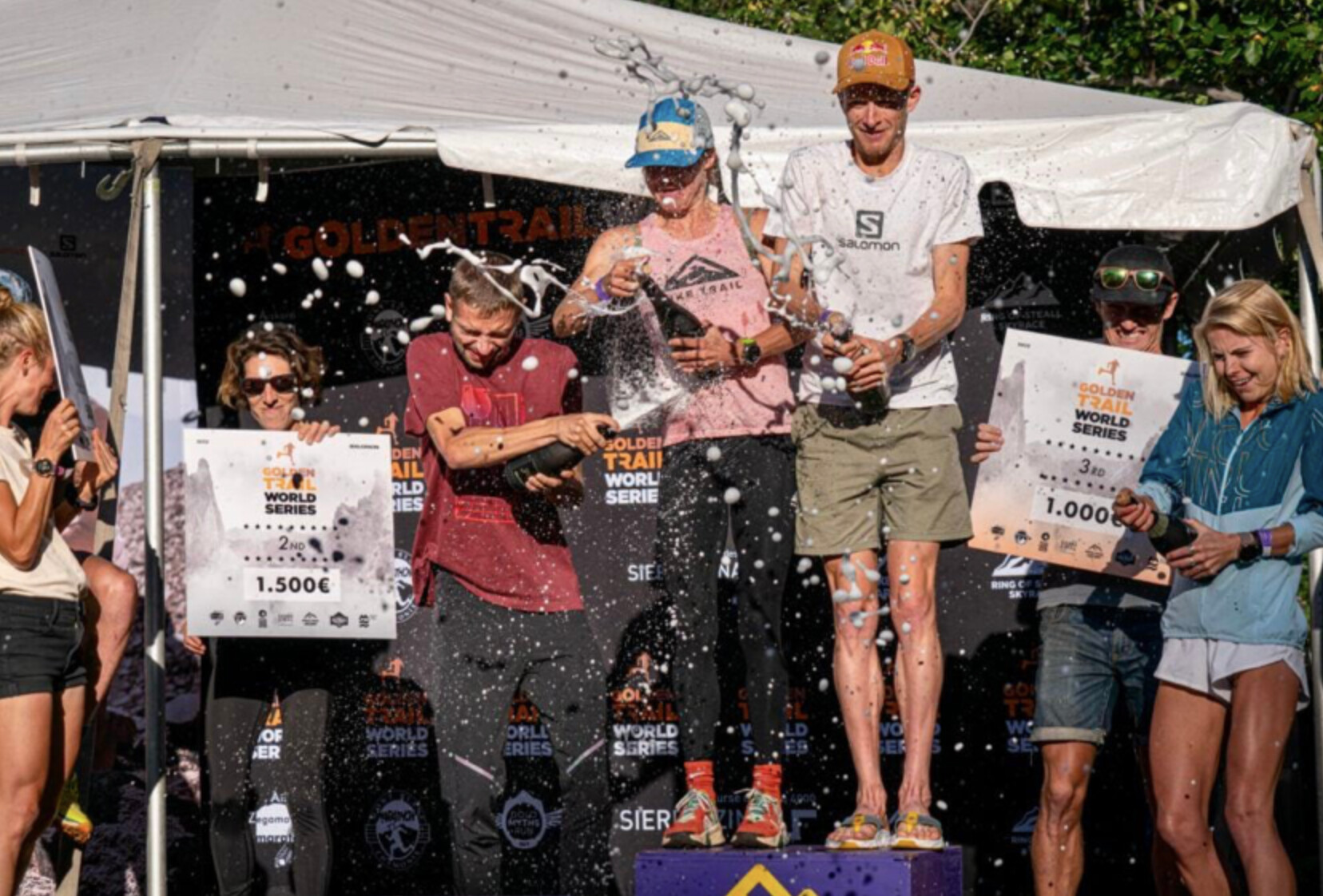
Run Rabbit Run is one of the rare American trail races that offers a relatively large prize purse, and for a decade, it's been the largest in the sport. Hughes earned $15,000 for winning the women's race and split another $5,000 with Arizona trail runner Peter Mortimer (who placed 12th overall) as part of the event's new team competition.
"That wasn't the reason I was drawn to the race, but it was definitely pretty cool to win that much money," Hughes said. "I'm glad I did it, because it wound up being a really great race with an amazing course on a beautiful day."
The origins of trail running were always more about the joy and freedom of ambling through the natural world, and less about the specific time and pace of any run or race, which is why winning big cash prizes is mostly uncommon in the sport, even for top-tier runners like Hughes. Over the past two years, Hughes has won 10 races of 50 miles or longer, yet her Run Rabbit Run victory was the first time she's ever earned money for her efforts.
More sponsorship money and bigger cash prizes are flowing into the sport, helping the top athletes earn a full-time living in the sport and become global stars. But that evolution has also created a desperate need for a unified governing body and more consistent drug-testing as doping becomes a more acute concern.
A Windfall of Prize Money
Historically, America's biggest and most notable trail running races haven't offered any prize money at all-Western States 100, Hardrock 100, Dipsea Trail Race, Leadville 100, Mount Marathon Race, Seven Sisters, Black Mountain Marathon/Mount Mitchell Challenge-partially because races simply couldn't afford to pay it, and also because, at the soul of the sport, that's not what the races were historically about or why most top runners were competing.
But with the continued growth of the sport-trail running has grown by 231 percent over the past 10 years, according to one report-and the dawn of a new level of professionalization over the past decade, there is a lot more money being injected into the sport. That includes more high-profile events and race series, more brands investing in the sport, more sponsored runners and trail running teams, as well as a growing expectation that prize money should be part of the equation as it is in road running, triathlon, and even obstacle course racing.
For many years, The North Face 50 near San Francisco was one of the only ultra trail races in the world to offer a significant prize purse. From its inception in 2006, until it disappeared after 2019, that race famously awarded $30,000 in prize money, which included $10,000 to the top finishers in the men's and women's races, plus $4,000 for second and $1,000 for third. It was a race to look forward to at the end of the calendar year, both for the cash awards and the prize-induced competition that drew top runners from around the world.
During that span, Run Rabbit Run, though a lower-profile race, quietly began dishing out some of the biggest payouts in the sport, in part because race organizers Fred Abramowitz and Paul Sachs believe in rewarding its top athletes for their efforts (as well as giving back to the community via even bigger charitable contributions). The race winnings come primarily from entry fees of the 600-runner event and sponsors, if and when the race has them. That wasn't possible back in the early days of the sport, when entry fees were minuscule and cash sponsors were mostly non-existent, but things have started to change.
Abramowitz and Sachs, who both earn their living as attorneys, are unique in that they want to give back to the elite athletes and the Steamboat Springs community, but they also want to help grow the sport. Abramowitz outlined what he calls "A Blueprint for Sponsors of Ultra Running," a three-page document that explains how and why trail ultrarunning-both as a sport and as individual races-can connect to more casual runners, sports fans, and the general public.
He points to the rampant growth of NASCAR, Professional Bull Riding, and professional poker over the past 20 years from their roots as fringe sports, relatively speaking, to mainstream spectacles with massive fan bases, TV contracts, and social media followings. Trail and ultrarunning aren't there yet, Abramowitz has noted, but they've certainly been growing rapidly.
"Today millions watch those events, though the actual number of participants is minuscule," Abramowitz wrote in his missive. "Ultrarunning can learn from these events: it needs new ideas, new ways of attracting the already committed runners and the casual sports fan to our terrific sport. Fields need to be competitive and races [need to be] dramatic; there are hundreds of 100-mile races, but those that offer competitive fields are a handful at most. Most ultra-races offer spectacular scenery in interesting venues."
Abramowitz said sponsors should support races such as Run Rabbit Run that offer prize money not merely because it's good for sport, but also because prize money can attract competitive fields, and competitive fields attract interest-from spectators, participants, potential sponsors, and the general public. He also points out that having prize money at more domestic races is a way to keep the sport from becoming entirely Euro-centric, which has been an increasing trend in the past several years.
The trend of cash purses seems to be increasing, and on the face of it, that's good for elite athletes capable of podium finishes. But it's a complex topic and one that certainly will simultaneously increase the competitiveness of the sport while, some argue, continue to pull the sport away from its organic, racing-in-nature roots that was mostly viewed as the antithesis of competitive road racing.
On the same day Run Rabbit Run paid out $75,000 in total prize money, the Pikes Peak Ascent awarded $18,000 in prize money for its top 10 finishers-including $3,000 apiece to the men's and women's winners-while the Pikes Peak Marathon, on September 18, had an additional $10,500 in total prize money for the top five runners. The races also offered $2,000 (Ascent) and $4,000 (Marathon), respectively, as course-record bonuses, and a $10,000 premium to any runner surpassing a pie-in-the-sky time well ahead of the course records. None of those records were broken, but the $28,500 in total prize money-partially backed by the Salomon-sponsored Golden Trail Series-was one of several large prize purses offered at U.S. races this year.
Other big American prize purses were also primarily tied to the Golden Trail Series events-the $50,000 spread over four races at the mid-June Broken Arrow Sky Races in Olympic Valley, California, and the September 25 Flagstaff Sky Peaks 26K race in Flagstaff, Arizona, where runners competed for $18,000 in prize money and a chance to compete at the Golden Trails World Series Final, and the $15,000 winner's earnings at the Madeira Ocean & Trails 5-Day Stage Race in October.
Also of note, the November 18-20 Golden Gate Trail Classic paid out $25,000 in total prize money to the top five finishers in both the 100K and half-marathon races, which were part of this year's nine-race $270,000 Spartan Trail World Championship Series.
Meanwhile, the Cirque Series, sponsored by On, paid out $3,600 in total prize money at each of its six sub-ultra mountain running races in the U.S., including $1,000 for the men's and women's winners. The Mt. Baldy Run-to-the-Top on September 5 in Southern California offered $3,000 to runners who broke the event's longstanding course records, and Joe Gray and Kim Dobson obliged by taking down each mark.
Most U.S. Trail and Mountain Running Championships have a minimum of $2,000 in prize money. Typically that comes from regional sponsors eager to support the local race organizations, such as the case with Northeast Delta Dental's contributions behind this year's Loon Mountain Race in Lincoln, New Hampshire, which hosted the U.S. Mountain Running Championships. That event had a $1,500 total prize purse that was paid out to the top three men and women in each race, but it also had an additional $1,500 for an Upper Walking Boss premium that was spread among the top three fastest times in each gender on the super-steep upper part of the course.
Meanwhile, the 2022 World Mountain and Trail Running Championships in Thailand paid out $66,000 to the top five finishers over four races, including $4,000 to the winners of each event.
"(The prize money) is way better than it's ever been, both for the athletes earning it and the number of sponsors who are contributing to it," says Nancy Hobbs, executive director of the American Trail Running Association and the chairperson of the USATF Mountain Ultra Trail Council that oversees national championship races and the U.S. Mountain Running Team.
From a longer view over the past decade or so, Joe Gray agrees there is more money coming into the sport than ever before. As a top-tier pro since 2008 and 21-time U.S. champion, he's regularly won more prize money at high-level races in Europe for more than a decade. But more than the growth of prize money, he has seen more brands interested in putting money behind athletes, races, and the sport in general.
"I think there has always been prize money there, and if you're successful you could make a lot more money really quickly," said Gray, a two-time World Mountain Running Champion. "I do think there is more money coming from the sponsors paying out better contracts and bigger bonuses, which I think will wind up being more beneficial to athletes overall."
Most elite trail runners get annual stipends from their sponsoring brands and bonus money for top performances. Gray is backed by Hoka, but he also has sponsorship deals with Fox River Socks, Kriva, Never Second, Knockdown, Tanri, Momentous, Casio, and GoSleeves. In addition to Hoka, Annie Hughes gets additional support from Ultraspire, Coros, and Tailwind Nutrition. But the life of professional trail runners-independent contractors who don't get healthcare and retirement program benefits-can get expensive with the growing cost of travel, regular bodywork/physio treatments, and private health insurance.
The sport's top-tier elite athletes-Joe Gray, Kilian Jornet, Courtney Dauwalter, Jim Walmsley, Maude Mathys, and Scott Jurek, among others-make a good living from their sponsorships. But there are really only a handful American trail runners making more than about $50,000 a year from shoe brand sponsorships. (Most "sponsored" trail runners are making somewhere between $10,000 to $30,000 per year.) The bottom line is that winning prize money, for those who are fast enough to consistently finish on the podium in big races, certainly helps make ends meet and is necessary to keep the sport's top athletes from having to work other jobs so they can focus entirely on training, recovery, and racing.
"This [2022] is the first year I've gone all-in on trail running," said Hughes, who worked as a waitress in Leadville the previous two years. "I'm able to live off what I make, but I'm not really saving anything. So it was really nice to win that money because then I can put some away in savings."
Higher European Standards
So far, Abramowitz appears to be right about the sport shifting to more of a European focus, and it's, at least in part, tied to the increased prize money that has attracted competitive athletes. While many top-tier European events have paid out modest prize purses for years, some of those races have also helped out visiting runners by way of travel stipends, hotel accommodations, or appearance fees. That's partially because European races are generally larger (500 to 1,000 participants or more) than U.S. races (typically fewer than 500 participants).
Unlike Hughes, who only raced in the U.S. this year, American runner Abby Hall, who runs for the Adidas-Terrex team, raced three times in Europe and earned prize money each time. She placed second in the Transgrancanaria 126K in the Canary Islands in March (which doubled as the Spartan Trail World Championship), finished third in the CCC 100K in Chamonix in August, and won the Transvulcania by UTMB 72K back in the Canary Islands in October.
Like Hughes, Hall receives an annual stipend and race bonuses from her sponsor, but admits it's been nice to have more opportunities to win money-both because it helps her make a living wage and because it's consistent with other professional endurance sports.
"In the past, it hadn't even been a consideration before, for how income would work out as an athlete," Hall said. "But this year it actually added up to be a decent amount. I'm grateful for the opportunities."
In 2022, American runner Hayden Hawks won an off-the-radar 100K a race in Krynica, Poland, and brought home the 100,000 zloty winner's prize ($26,000), one of the bigger individual purses ever awarded in trail running. In 2017, when Hawks won the CCC race, he didn't win anything because UTMB had refused until 2018 to offer prize money at its races, partly because race founders Catherine and Michel Poletti have believed that increased prize money will bring more incentive for some athletes to consider doping or that agents would take too big of a cut.
UTMB finally began offering prize money to podium finishers in 2018 with a total purse of about $34,000 (35,000) and continued that through 2021. But after forging a business relationship with Ironman and launching the new UTMB World Series, it has increased the prize money awarded in Chamonix. In 2022, UTMB said it paid out about $162,000 in total prize money (the approximate equivalent of its stated 156,000 prize purse) to the top 10 men and women finishers of the UTMB, CCC, and OCC races.
That includes $10,400 to the winners of each of those races, with approximately $5,200 going to second-place finishers and $3,125 for third. Fourth- and fifth-place finishers in each of those races earned about $1,500, while 6th through 10th took home $1,000.
While those more notable ultrarunning paydays can be big windfalls for a trail runner, they still pale in comparison to what elite-level road marathoners and triathletes earn at the biggest races that have a much larger audience, including live TV coverage. For example, the 2022 Boston Marathon awarded $876,500 in prize money and $150,000 to the winners, while New York City Marathon paid out $530,000 in total prize money at its November 6 race, including $100,000 to the men's and women's winners. The 2021 Ironman World Championships in St. George, Utah, had a $750,000 prize purse, including $125,000 to the winners, similar to what was awarded at the 2022 Ironman World Championships October 6-8 in Hawaii.
While only a few top trail runners could have opted to pursue a marathon or triathlon career instead of trail running, what's more relevant is the spike of growth trail running. Although it is not yet internationally televised as major marathons and triathlons are, the surge in participation and livestream viewing options is starting to bring in more media attention and sponsorship money than ever before. And more media attention begets more participation and professionalization.
"I think we'll definitely see ultra-trail running continue to grow for years to come," says Mike McManus, director of global sports marketing for Hoka. "I think it's at a point where it's just on the cusp of the real growth that's coming and all that will come with it, similar to where the marathon was in the 1980s and triathlon in the 1990s. It might never be as big as marathoning, but trail running will definitely get more built out as it continues to grow."
"It's nice to make some money for the sport we do. This is my job, and being able to support my family with a decent chunk of money is pretty nice," Hawks says. "I definitely don't go after races just for money, but if there is a gap in my schedule where I can win a little bit of money, I am definitely going to take advantage of that for sure. I want to continue to be in this sport and live this lifestyle as long as I can, so knowing that there are sponsors and races investing more in runners is something I am really grateful for."
The Ongoing Dilemma
While Abramowitz and Sachs have been eager to give out prize money at Run Rabbit Run, not all races are equipped to do so. Many U.S. races are garage-shop operations that barely break even, while some are just too small to make it happen. The Western States 100-Mile Endurance Run (WSER) is operated by a non-profit organization, and offering prize money goes against the mission of the race, says race director Craig Thornley.
The biggest concern that race directors have, including Thornley, is that prize money attracts athletes willing to use performance-enhancing drugs because the sport lacks a comprehensive anti-doping strategy that includes both post-race testing and out-of-competition testing.
"In general, I think the prize money is probably a good thing because professional athletes are able to make a living," Thornley said. "But I think, as a sport, we'll probably have to be more aware of people trying to use drugs or some other ways to get that prize money."
A few years ago, the Western States 100 famously announced its zero-tolerance policy regarding the use of performance-enhancing drugs (PEDs) that prohibits any athlete who has been determined to have violated anti-doping rules or policies-by World Athletics, World Anti-Doping Agency (WADA), U.S. Anti-Doping Agency (USADA), or any national sports federation-is ineligible for entry into the WSER. Although Western States has regularly drug-tested its top finishers, only a few other big trail or ultra-distance races test its finishers with a WADA-sanctioned program.
Thornley believes the incentive to cheat has probably increased as more brands have stepped up to sponsor athletes, but the increase in prize money probably makes it more tangible.
He's not the only one. Ultrarunning coach and podcaster Jason Koop, an outspoken proponent for authentic drug-testing in the sport, agrees, saying that it's time for the sport to collectively start developing mandatory drug-testing protocols, even on a small scale. While he doesn't believe doping is prevalent in trail running, he believes it's definitely already an issue.
"People would be fooling themselves if they thought that every trail running performance was clean. If you think that that's the case, then I have a bridge to sell you," Koop says. "Prize money or no prize money, I think the bigger thing is that the ecosystem is developed enough and there is enough financial reward at stake to where everyone kind of owes it to everybody else to get something done."
In other words, it's time for the sport to take some next steps-either by big governing bodies or small factions of people interested in the long-term health of the sport-to develop more structure and universal anti-doping policies.
(01/14/23) Views: 122Trail Runner Magazine
The 2023 Houston Marathon is set to take place this weekend: Here’s what you need to know
The weather is expected to be a bit warmer this year, reaching the mid 60s on Saturday and the 70s on Sunday.
Tens of thousands of runners are set to participate in the 2023 Chevron Houston Marathon and Aramco Houston half marathon this weekend.
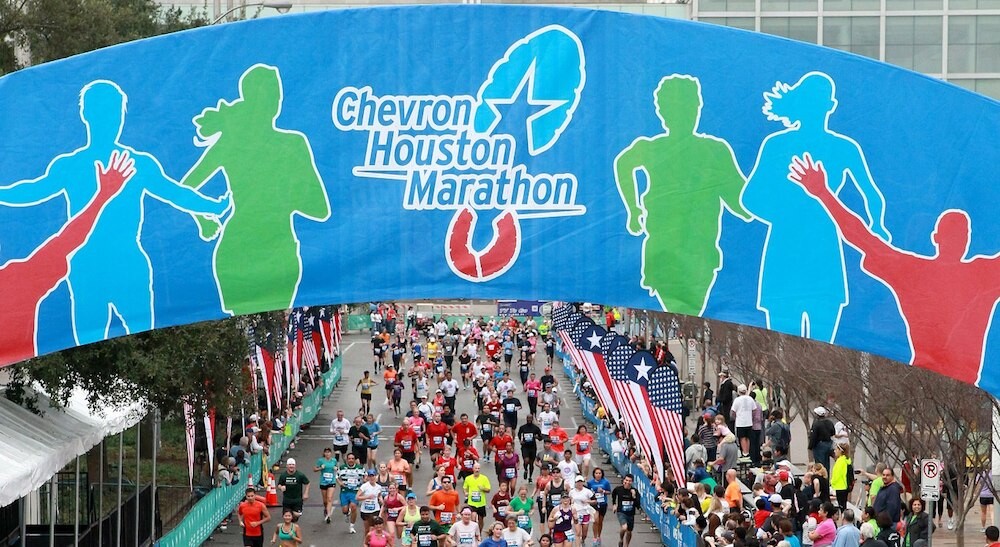
On Saturday morning, the We Are Houston 5K will began at McKinney & Crawford:
6:30 a.m. — 5K race day packet pick-up opens
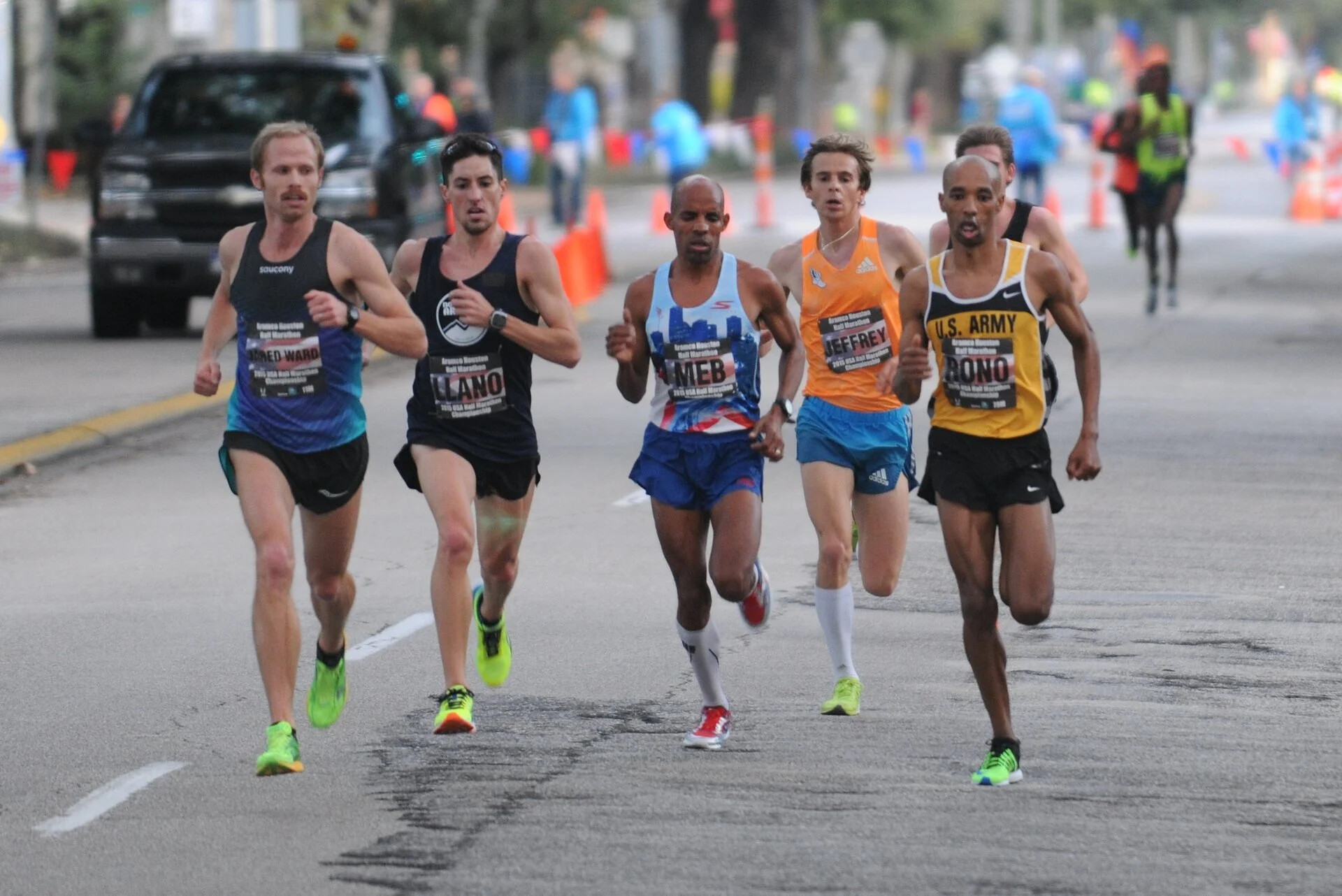
7:50 a.m. — Wheelchair start
8 a.m. — Race start
On Sunday, the Chevron Houston Marathon & Aramco Houston Half Marathon will start at Congress & Fannin:
6:50 a.m. — Marathon and half marathon wheelchair start
7:01 a.m. — Marathon and half marathon start
During a press conference on Friday, Houston Police Chief Troy Finner said hundreds of law enforcement will be present during the race.
“Please, if you see something, say something,” Finner said.
The weather is expected to be a bit warmer this year, reaching the mid 60s on Saturday and the 70s on Sunday, according to Space City Weather.
Dr. Lars Thestrup, the medical director of the Houston Marathon Committee urged runners to use their best judgement during the race and to take it slow, if needed.
“This is may not be the year to attempt for a personal best on your half or your full marathon. You may want to take it a little slower,” Thestrup said. “The key is respect your limits and listen to your body.”
Thestrup said a total of 22 aid stations will be set up along the course, along with 20 medical bike teams in case of emergencies. He added that several METRO buses will be located along the route to serve as cooling stations for runners.
(01/14/23) Views: 116Lucio Vazuez
Shalane Flanagan’s stir-fry recipe: a ‘choose your own adventure’ meal
Every household should have an easy, quick stir-fry to whip up on busy days, and Shalane Flanagan‘s recipe, packed with veggies of your choice, is versatile and easy to match the tastes you’re cooking for.
Flanagan, a four-time Olympian (twice in the marathon) and the 2017 New York City Marathon champion, may be retired from professional competition, but she’s still a busy coach for Bowerman Track Club, a mom, and co-author of three cookbooks with her former teammate and friend, Elyse Kopecki.

Flanagan says her family counts on a weekly stir-fry to use up what they have at home and suggests: “choose your own adventure, but aim for a range of colors to max out nutrition potential.”
Shalane and Elyse’s Eat the Rainbow Stir-Fry

Ingredients (marinade)
8 ounces skinless chicken, chopped
2 Tbsp soy sauce
1 Tbsp lime juice
2 Tbsp honey
1 Tbsp minced garlic and/or ginger
Veggies
2 Tbsp high-heat oil (like sesame, avocado or safflower oil)
1/2 large or 1 small onion, sliced
2 heaping cups chopped hard vegetables (broccoli, carrots, celery)
1 heaping cup sliced soft vegetables (snap peas, bell pepper, cabbage, box choy, mushrooms)
Directions
Place the chicken, soy sauce, lime juice and honey in a quart-size zipper bag and shake to combine. Leave out for 20 minutes to allow meat to marinate and come up to room temperature (for even more meat flavour, marinate overnight in the fridge).
Heat a wok or high-sided sauté pan over high heat. Add the oil, onion and hard vegetables. Cook, stirring frequently until the veggies begin to brown–about five minutes.
Turn the heat down to medium-high, add the soft vegetables, and sauté for about two minutes. Add the chicken with the marinade and sauté, stirring occasionally, until the chicken is cooked through, about five minutes.
Use a clean spoon to serve on top of brown rice or quinoa (or noodles) and drizzle with your favourite sauce, like sriracha or peanut sauce.
Flanagan’s tips: Prep all the veggies before frying, and chop veggies to similar sizes so that they cook evenly. Cook hard vegetables first, and moisture-rick ingredients last, and make sure your pan is really hot (and keep it hot). Don’t walk away: stir-frying means quick cooking over high heat with frequent stirring.
(01/13/23) Views: 108Running Magazine
Defending champion Hurisa eyes winning return in Tata Mumbai Marathon
Defending champion Derara Hurisa is back to where his marathon journey began — the prestigious Tata Mumbai Marathon — as he eyes a winning return from injury in the upcoming 18th edition on Sunday, January 15.
The 25-year-old Ethiopian clinched the 2020 crown with a blistering course record of 2:08:09 and went on to win both his outings over the classic distance in 2021 — Vienna and Guadalajara Marathon (Mexico) — but was disqualified in Austria due to a shoe technicality.

He spent 2022 recovering from a hip injury.
“I’ll try to defend my title, but the competition here is really good,” Hurisa told a news conference on Saturday. “My training was nice, with the focus on the Tata Mumbai Marathon,” he added.
In the men’s field, 10 runners hold personal bests under the course record, including Hurisa’s compatriot and training partner Hayle Lemi.
The 28-year-old is a winner of seven marathons, including the Boston Marathon in 2016 and Dubai in 2015. “The conditions here look good for me,” said Lemi, a.k.a. Lemi Berhanu, runner-up in the 2021 Boston Marathon in 2:10.37 and with a preference for warm weather.
Leading the Kenyan charge in the men’s International Elite field of 16 is Philemon Rono, the training partner of marathon legend Eliud Kipchoge. “My training has been good, I just got to go out there and express myself,” said the 31-year-old, who finished an impressive sixth at the 2019 Boston Marathon and won the Toronto Marathon for the third time that year in 2:05:00.
The women’s International Elite field will feature 2019 winner Worknesh Alemu of Ethiopia and the 2020 runner-up from Kenya, Rodah Jepkorir Tanui, and six runners with personal bests under the course record (2.24.33), headlined by the experienced Kenyan Sharon Cherop.
The 18th edition of the USD 405,000 prize fund World Athletics Gold Label Road Race takes place after a two-year pandemic-forced break and will also witness over 55,000 amateurs across six categories on its much-awaited return.
The elite men’s and women’s winners will take home USD 45,000 each. The runners will be further incentivized by a Course Record Bonus of USD 15,000.
(01/13/23) Views: 103Albert Korir, Shura Kitata and Gabriel Geay confirmed to take on Kipchoge in Boston
Major marathon winners Albert Korir and Shura Kitata, as well as 2015 world champion Ghirmay Ghebreslassie, are among the many additions to the men’s elite field for the Boston Marathon on April 17, organizers of the World Athletics Elite Platinum Label road race announced today (11).
Today’s announcement expands upon four previously announced men’s entrants including world record-holder and double Olympic champion Eliud Kipchoge, reigning Boston Marathon champion Evans Chebet, 2021 winner Benson Kipruto, and two-time victor Lelisa Desisa.
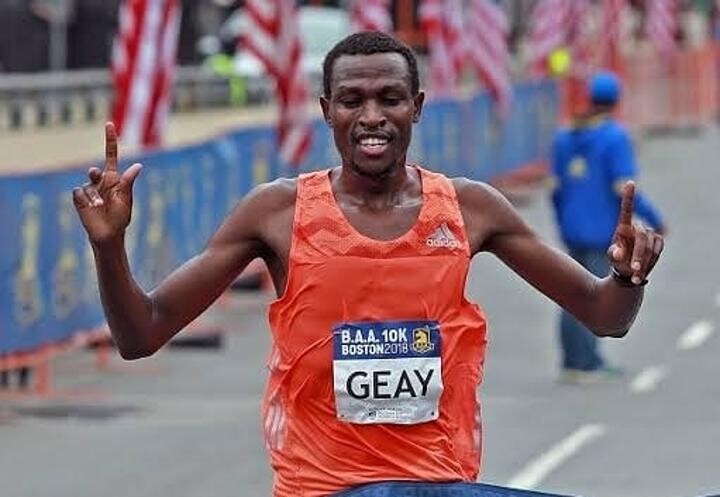
It brings the total number of sub-2:07 performers in the field to 15. Eight of those have bettered 2:05.
Korir, the 2021 New York Marathon champion, made his Boston debut last year and finished sixth. But Kitata, who beat Kipchoge to win the 2020 London Marathon champion, and Ghebreslassie will be making their Boston Marathon debuts.
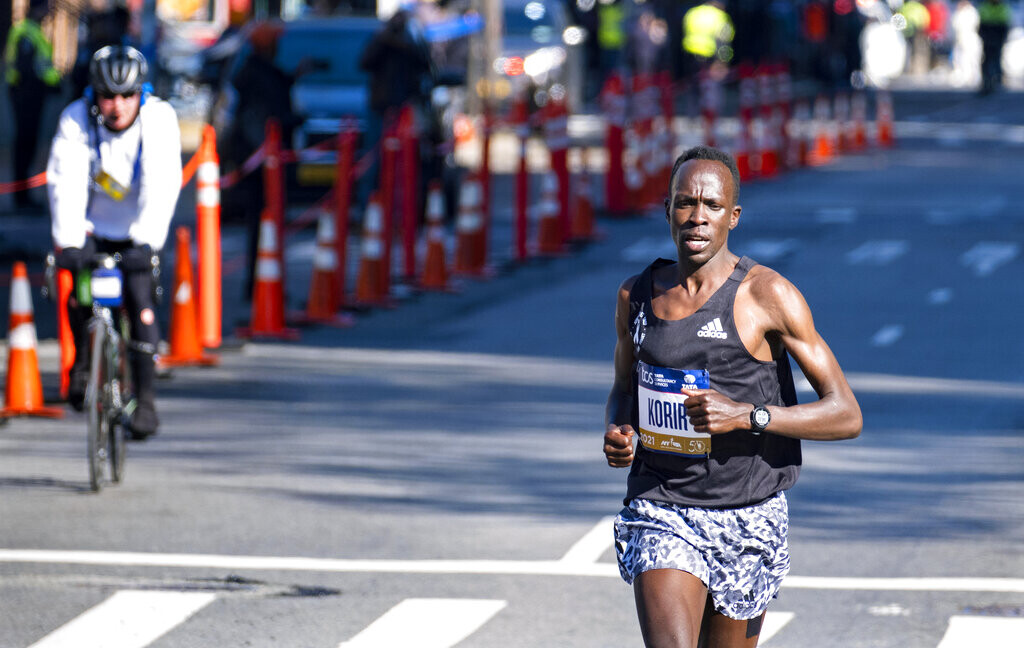
Tanzanian record-holder Gabriel Geay is the third fastest man in the field, after Kipchoge and Chebet. Geay, who finished runner-up at the Valencia Marathon last month in 2:03:00, has had success racing on the roads of Boston, winning the 2018 Boston 10K and placing fourth at last year’s Boston Marathon.
“I am excited to be returning to the Boston Marathon this year,” said Geay. “I fulfilled a dream by racing in Boston last year, but my goal is to one day win the race, and I hope that 2023 will be my year.”
Brazilian Olympian and national record-holder Daniel Do Nascimento will make his Boston debut, as will Ethiopia’s Herpasa Negasa, a 2:03:40 marathon runner. Augustine Choge, one of the most versatile runners in the world, will also line up in Boston, hoping to conquer the marathon distance once and for all.
After a 2:08:16 marathon debut in Chicago last year, USA’s Conner Mantz will take on the Boston course for the first time. He will be joined by world 50km record-holder CJ Albertson.
(01/13/23) Views: 96World Athletics
Hate hills? Here’s how to change that, pro ultrarunner Emelie Forsberg shares her tips and favorite uphill workouts
Hill workouts can be tough. They are also a powerful tool for building strength, making your body injury-resistant, and translate to speed on the flats: if you can learn to enjoy them it’s much easier to get out there.
“I love the feeling of being able to push myself to the max, as if the resistance is my friend,” Norway-based ultrarunner and ski mountaineering pro Emelie Forsberg shares in her book Sky Runner.
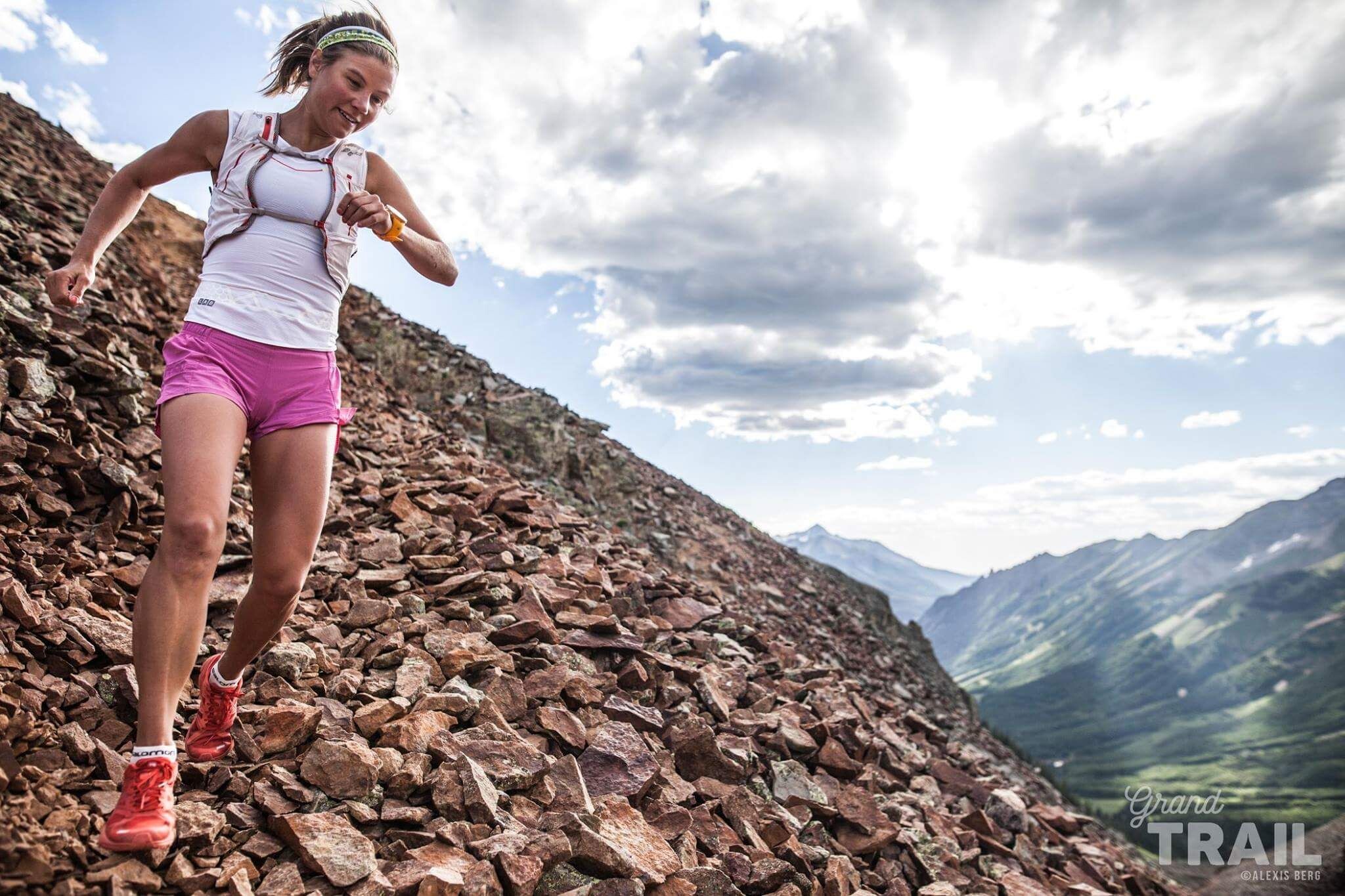
Try these tips and workouts to find your groove as you test out (or build on) your hill-climbing abilities. You, too, may soon be loving your uphill sessions.
Find the right technique

Forsberg suggests trying to make hill running as comfortable as possible by finding the right technique for the hill you’re on. For very steep hills she suggests switching between two methods of climbing: walking very fast with large strides, pushing against your thighs with your hands and arms, and taking shorter, faster steps with a higher turnover rate.
“Neither of these are faster than the other, but it’s nice to switch between the two techniques to use different muscle groups,” Forsberg explains, noting that she finds the shorter strides harder so opts to work on them more often in training. “I want to train with what I’m less comfortable with.”
Easier hill intervals
Forsberg suggests trying this session (adjusting the number of intervals to your ability) if you’re new to hills or returning to interval training, and says the pace and effort “should feel manageable the entire time.”
Warm up with 10 minutes easy running
10 x 2 minutes, easy run downhill for recovery (approx one minute)
Cool down with 10 minutes easy running
Hill sprints
“This is a very explosive exercise that can be very hard,” shares Forsberg, suggesting runners start moderately with fewer repetitions and increase accordingly. “It’s much more fun to get a positive surprise rather than never wanting to do the exercise again,” she explains. We definitely agree.
Warm up with 10 minutes of easy running
10 x 30 seconds of hard running with 30 seconds rest
Repeat 3x, with 2 minutes of recovery time in between each block
Cool down with 10 minutes of easy running
After a challenging uphill or speedwork session, make sure to take a recovery day or do some very easy running.
(01/13/23) Views: 95Keeley Milne
Yalemzerf Yehualaw will challenge her global mark of 29:14 this weekend in Valencia
Get ready for some quick times on Sunday (Jan 15) when the self-styled “ciudad del running” stages its annual 10km Valencia Ibercaja event on its famously fast roads.
Many of the world’s top distance runners will descend upon the Spanish city this weekend in search of record-breaking performances. These include Yalemzerf Yehualaw, who will attack her own women’s world record of 29:14 set in Castellón 11 months ago.
The 23-year-old impressed over the marathon last year, too, as she clocked what was, at the time, the world’s fastest ever debut by a woman with 2:17:23 in Hamburg before later capturing the London Marathon title in 2:17:26.
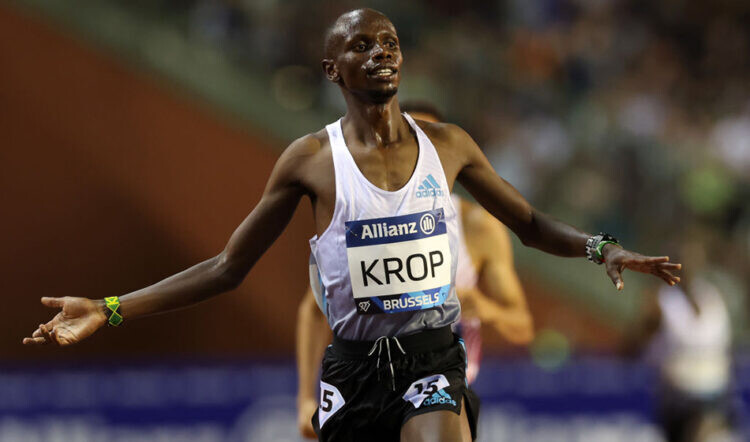
British athletes are in Valencia in force too. The Spanish road race clashes with the trial in Perth, Scotland, for the World Cross Country Championships, but many have opted to slip on their super-shoes rather than spikes to chase PBs on the road.
Yehualaw is the star attraction and will wear No.1 on her singlet on Sunday, but she is joined in Valencia by fellow Ethiopian Ejgayehu Taye, who holds the world 5km record with 14:19 from Barcelona in 2021. In addition, Karoline Grøvdal of Norway will attack the European record of 30:05 held by Lonah Salpeter of Israel.
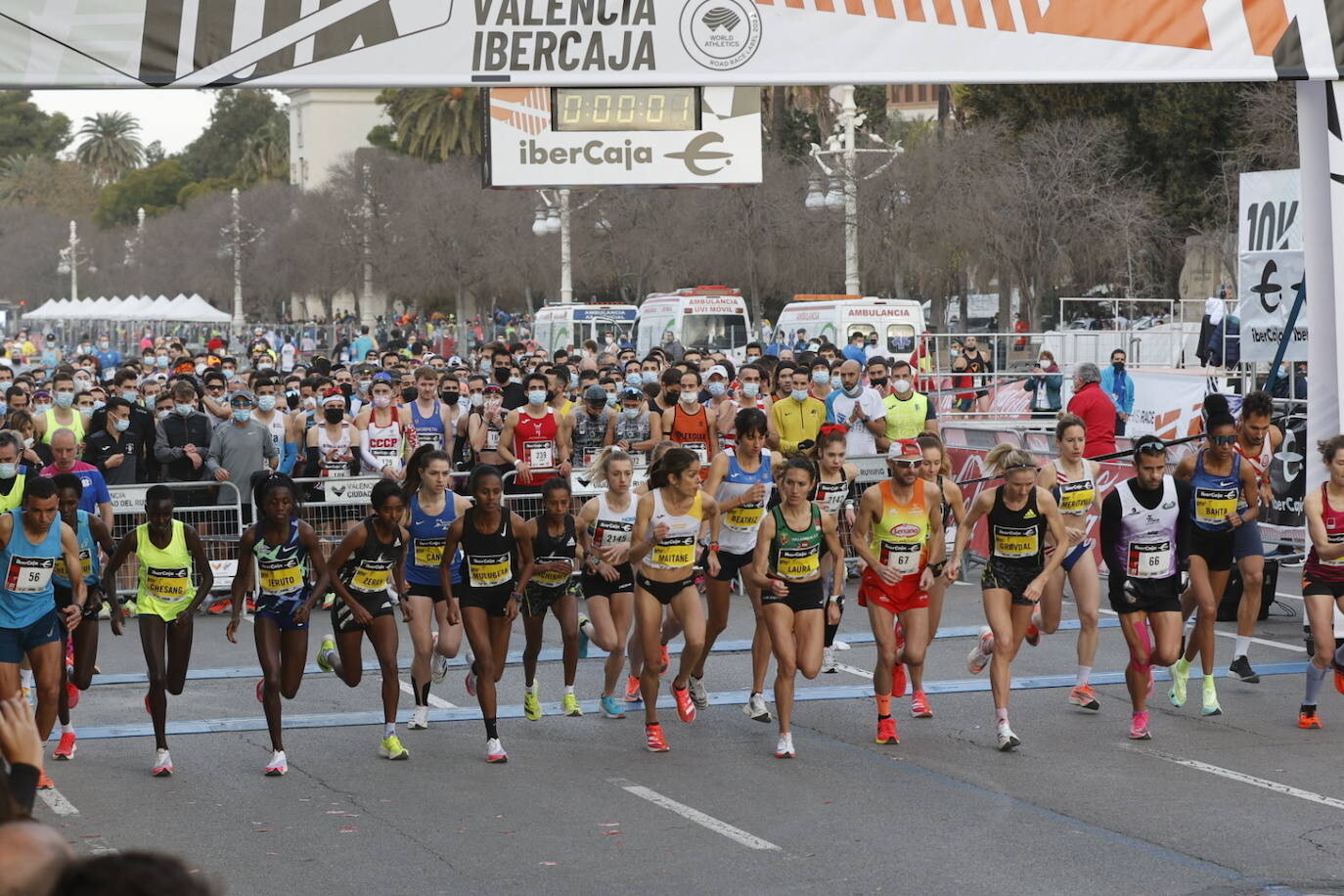
In the men’s field, sub-27min performers Richard Kimunyan Yator and Weldon Kipkirui Langat of Kenya plus Rodrigue Kwizera of Burundi lead the men’s entries in a field of around 11,000 runners which is set to feature about 100 elite athletes from 15 different nations.
Jacob Krop, the world 5000m silver medallist and 12:45.71 runner on the track, is also in the line-up together with Paul Chelimo of the United States, while Morhad Amdouni and Jimmy Gressier of France lead the European challenge.
Their target is Rhonex Kipruto’s world record of 26:24, which was set in this event in 2020.
“We want the men to approach the European record (27:13 by Julien Wanders set in Valencia in 2020) and, with the African armada, to look for sub-27 records and even approach the world record,” said Acuña. “The 2023 race will be the most competitive of all editions. The best European athletes want to run the 10km Valencia Ibercaja – and we have been working for months in that direction.”
He added: “The goal of the race is to become more international year after year and reach more and more countries. We are a world reference for the distance and the best athletes want to run in Valencia.”
Don’t be surprised to see the UK all-time rankings revised on Sunday when a large contingent of British athletes tackle the Valencia 10km.
They are led by Samantha Harrison, who already sits No.5 on the UK all-time rankings with 31:10 from Telford in December.
Calli Thackery, the fifth quickest British woman in history over 5km with 14:58, is also set to compete. Add to this Olympic marathoner Steph Twell, plus Amelia Quirk, Lucy Reid and Sarah Astin.
One week after out-kicking Jake Wightman indoors over 3000m, Phil Sesemann takes to the roads looking to beat his 28:24 PB from 2019.
The Mahamed brothers – Mahamed and Zak – are also in the line-up, plus Olympic 5000m finalist Andy Butchart, Efrem Gidey, Ellis Cross, Calum Elson and Kadar Omar.
The list goes on with Kieran Clements, Jack Gray, Jonathan Hopkins, Alfie Manthorpe, Lewis Jagger, Ronny Wilson, Jonny Davies, Alex Lepetre, Jonathan Escalante, Dan Studley, Norman Shreeve and Corey De’Ath.
(01/13/23) Views: 93Jason Henderson


